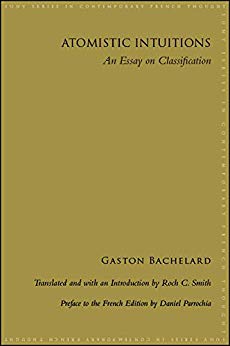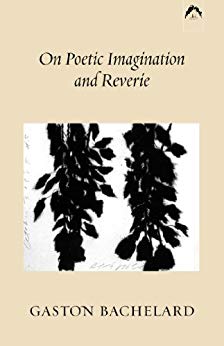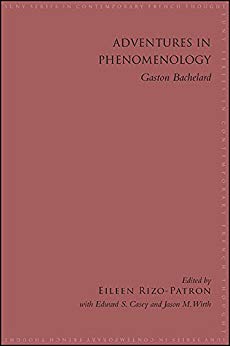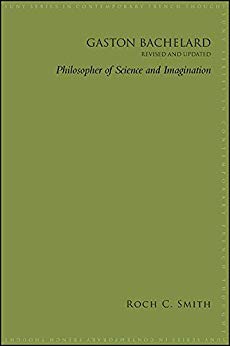Background
Gaston Bachelard was born on June 27, 1884 in Bar-sur-Aube, France.

1961
Portrait of Gaston Bachelard, photographed at his home in Paris on November 6, 1961.
1961
Portrait of Gaston Bachelard, photographed at his home in Paris on November 6, 1961.
1961
Portrait of Gaston Bachelard, photographed at his home in Paris on November 6, 1961.
1961
Gaston Bachelard in Paris.
1961
Gaston Bachelard, photographed at his home in Paris on November 6, 1961.
Gaston Bachelard. An amazing writer and thinker.
The University of Paris, Paris, France
Gaston Bachelard received his Bachelor of Arts degree in 1920 from the University of Paris, and then in 1927 he was a D.-ès-Lettres, 1927.









(An English translation of Bachelard's sixth book, in whic...)
An English translation of Bachelard's sixth book, in which he seeks to develop a metaphysical context for modern atomistic science. French philosopher Gaston Bachelard (1884–1962) is best known in the English-speaking world for his work on poetics and the literary imagination, but much of his oeuvre is devoted to epistemology and the philosophy of science. Like Thomas Kuhn, whose work he anticipates by three decades, Bachelard examines the revolution taking place in scientific thought, but with particular attention to the philosophical implications of scientific practice. Atomistic Intuitions, published in 1933, considers past atomistic doctrines as a context for proposing a metaphysics for the scientific revolutions of the twentieth century. As his subtitle indicates, in this book Bachelard proposes a classification of atomistic intuitions as they are transformed over the course of history.
https://www.amazon.com/Atomistic-Intuitions-Classification-Contemporary-Thought-ebook/dp/B07GZB159L/?tag=2022091-20
1933

(A beloved multidisciplinary treatise comes to Penguin Cla...)
A beloved multidisciplinary treatise comes to Penguin Classics Since its initial publication in 1958, The Poetics of Space has been a muse to philosophers, architects, writers, psychologists, critics, and readers alike. The rare work of irresistibly inviting philosophy, Bachelard’s seminal work brims with quiet revelations and stirring, mysterious imagery. This lyrical journey takes as its premise the emergence of the poetic image and finds an ideal metaphor in the intimate spaces of our homes. Guiding us through a stream of meditations on poetry, art, and the blooming of consciousness itself, Bachelard examines the domestic places that shape and hold our dreams and memories. Houses and rooms; cellars and attics; drawers, chests, and wardrobes; nests and shells; nooks and corners: No space is too vast or too small to be filled by our thoughts and our reveries.
https://www.amazon.com/Poetics-Space-Gaston-Bachelard-ebook/dp/B00L2GPRLI/?tag=2022091-20
1958

(Passages from Bachelard's major works are introduced here...)
Passages from Bachelard's major works are introduced here in excerpts selected by Colette Gaudin, a professor of French literature at Dartmouth College and an authority on Bachelard.
https://www.amazon.com/Poetic-Imagination-Reverie-Gaston-Bachelard-ebook/dp/B00IU1JTMG/?tag=2022091-20

(Repositions Bachelard as a critical and integral part of ...)
Repositions Bachelard as a critical and integral part of contemporary continental philosophy. Like Schelling before him and Deleuze and Guattari after him, Gaston Bachelard made major philosophical contributions to the advancement of science and the arts. In addition to being a mathematician and epistemologist whose influential work in the philosophy of science is still being absorbed, Bachelard was also one of the most innovative thinkers on poetic creativity and its ethical implications. His approaches to literature and the arts by way of elemental reverie awakened long-buried modes of thinking that have inspired literary critics, depth psychologists, poets, and artists alike.
https://www.amazon.com/Adventures-Phenomenology-Bachelard-Contemporary-Thought-ebook/dp/B074GDJ86G/?tag=2022091-20

(Comprehensive overview of the entire spectrum of works by...)
Comprehensive overview of the entire spectrum of works by one of twentieth-century France’s most original thinkers. Gaston Bachelard, one of twentieth-century France’s most original thinkers, is known by English-language readers primarily as the author of The Poetics of Space and several other books on the imagination, but he made significant contributions to the philosophy and history of science. In this book, Roch C. Smith provides a comprehensive introduction to Bachelard’s work, demonstrating how his writings on the literary imagination can be better understood in the context of his exploration of how knowledge works in science. After an overview of Bachelard’s writings on the scientific mind as it was transformed by relativity, quantum physics, and modern chemistry, Smith examines Bachelard’s works on the imagination in light of particular intellectual values Bachelard derived from science.
https://www.amazon.com/Gaston-Bachelard-Revised-Updated-Contemporary-ebook/dp/B01GQN6D46/?tag=2022091-20

(In The Dialectic of Duration Gaston Bachelard addresses t...)
In The Dialectic of Duration Gaston Bachelard addresses the nature of time in response to the writings of his great contemporary, Henri Bergson. The work is motivated by a refutation of Bergson’s notion of duration – ‘lived time’, experienced as continuous. For Bachelard, experienced time is irreducibly fractured and interrupted, as indeed are material events. At stake is an entire conception of the physical world, an entire approach to the philosophy of science. It was in this work that Bachelard first marshalled all the components of his visionary philosophy of science, with its steady insistence on the human context and subtle encompassing of the irrational within the rational. The Dialectic of Duration reaches far beyond local arguments over the nature of the physical world to gesture toward the building of an entirely new form of philosophy.
https://www.amazon.com/Dialectic-Duration-Groundworks-Gaston-Bachelard-ebook/dp/B01LZKURE3/?tag=2022091-20

(An English translation of Bachelard's sixth book, in whic...)
An English translation of Bachelard's sixth book, in which he seeks to develop a metaphysical context for modern atomistic science. French philosopher Gaston Bachelard (1884–1962) is best known in the English-speaking world for his work on poetics and the literary imagination, but much of his oeuvre is devoted to epistemology and the philosophy of science. Like Thomas Kuhn, whose work he anticipates by three decades, Bachelard examines the revolution taking place in scientific thought, but with particular attention to the philosophical implications of scientific practice. Atomistic Intuitions, published in 1933, considers past atomistic doctrines as a context for proposing a metaphysics for the scientific revolutions of the twentieth century.
https://www.amazon.com/Atomistic-Intuitions-Classification-Contemporary-Thought-ebook/dp/B07GZB159L/?tag=2022091-20
critic Epistemologist philosopher scientist
Gaston Bachelard was born on June 27, 1884 in Bar-sur-Aube, France.
Gaston Bachelard received his Bachelor of Arts degree in 1920 from the University of Paris, and then in 1927 he was a postmaster in Bar-Sur-Aube, and then studied physics before finally becoming interested in philosophy.
At first, Bachelard taught physics and chemistry in the collège of his native city. His knowledge of physics later enabled him to determine the epistemological change brought about by modern science and, particularly, to gauge the growing distance between it and classical physics, which had suddenly become only relative.
As early as 1928, in the Essai sur la connaissance approchée, Bachelard penetrated to the heart of the new mathematical physics and began to simplify its methods of measuring (calculus of errors), experimenting, and generalizing. A complementary study, Étude sur I’évolution d’un problème de physique (1928), was designed to show how thermodynamics was both established by and liberated from its early, very poor intuitions (such as that a metal bar heated at one end will become longer). His study of conductibility in anisotropic media, and the mathematical theory of Poisson and Fourier, facilitated the integration of thermodynamics with mechanics, especially since heat was not linked to an isolated molecule but was determined within a rather large volume (the quantitative view).
As early as 1930 Bachelard’s work branched out in several directions. One was pedagogical, concerned with how to arouse the mind and modernize it so that it could participate in the formulation of scientific concepts. This led to La formation de I’esprit scientifique (1938), in which Bachelard examines mental resistances and prejudices anthropologically and methodologically, in order to expose them. His original objective was to apply Freud’s psychoanalytic method to epistemology and to science itself, and to draw up a highly systematic list of complexes that paralyze intelligence.
Bachelard’s work was also historical: he became the historian of scientific changes. He did not give a chronological description of the evolutionary stages of thought as it grappled with reality, but clarified its tensions and expressed its breakdowns. These tensions and breakdowns occurred because modern physics attacked what had previously been considered basic principles.
A vast prescientific or, as it were, prehistroic universe underlies the period of concentrated scientific discovery - the revolution that substituted the surrationalism of the twentieth century for the rationalism of the nineteenth. If this rationalism conditions our view of the science of the eighteen and, a fortiori, the preceding centuries, it by no means invalidates it. Bachelard used earlier, naive physics as a subject for a new study of elemental pstchology. Alchemy represented for him the projection of the soul’s desries the magic lantern that enlarged derams. From this belife came his celebrated analyses of the classical four elements and of derams, space, time, and imagination.
Bachelard was never satisfied merely to point out obstructive archaisms. He went further, introducting the reader to the most abstract categories of contemporary science. From generalities, he moved on to make specialized analyses on the point, the corpuscle, movement, space, and the simultaneous. Bachelard also simplified the dialectic contained in apparatus that embodied a theory and the Wilson could chamebr also simplified the dialectic contained in apparatus thatembodied a theory: the Wilson could chamber, the spectroscope and the particle accelerator, “Phenomenotechnology” replaced instruments based on calculating systems; probabilism replaced realism: the discursive replaces the intuitive.
Bachelard attempted to renew the traditional questions of philosophy and physical reality. He sought to base metaphysics upon the new physics and to resume the work of Descartes, Newton, and Leibniz.
All these avenues of endeavor cut across each other. With Bachelard the past became the poetry of the world; classical science, a basis for exploration and enlargement; and modern science, a phenomenon that must constantly be reviewed.
He died on October 16, 1962 in Paris, France.
Gaston Bachelard`s main achievement was in becoming one of the most prominent philosophers of the twentieth century. His most important work is on poetics and on the philosophy of science titled The Poetics of Space. To the latter he introduced the concepts of epistemological obstacle and epistemological break (obstacle épistémologique et rupture épistémologique). He influenced many subsequent French philosophers, among them Michel Foucault and Louis Althusser.
(A beloved multidisciplinary treatise comes to Penguin Cla...)
1958(Passages from Bachelard's major works are introduced here...)
(In The Dialectic of Duration Gaston Bachelard addresses t...)
(An English translation of Bachelard's sixth book, in whic...)
1933(An English translation of Bachelard's sixth book, in whic...)
(Comprehensive overview of the entire spectrum of works by...)
(Repositions Bachelard as a critical and integral part of ...)
The features of the world which most concerned Bachelard were change and discontinuity, especially in the working of the mind. Trained as a scientist and deeply impressed by relativity, he began his intellectual career with a sustained attack on the positivistic idea of scientific progress as a neat process of the accretion of truths. Discoveries, he argued, are more accurately regarded as discontinuities. Later in life, turning
his attention to artistic creativity, he argued forcibly against the deterministic criticism of the school of Sainte-Beuve, in Bachelard’s view false to the real workings of the imagination. Scientific discoveries and works of art are important discontinuities in the world.
The growth of scientific knowledge, Bachelard argues, is not a neat, sequential piling up of new truths, as the positivists have presented it. Discoveries are made not by those who accept current science but by those who say no to it, those who correct errors, and discoveries frequently involve revisions of concepts at all levels, down to the most fundamental. The assumption, for example, that the notion of reason as enshrined in traditional rationalism is fixed for all lime is untenable: ‘Reason must obey science.. which is evolving’. The outmoded assumptions of such rationalism Bachelard replaces by his preferred method, surrationalism: mutable, polymorphic and in principle révisable at all levels of conceptual generality. This method furthers rather than stifles the mental process at the heart of discovery, the sudden intuition which goes beyond currently received belief sets. Everything which presents itself as a final discovery or immutable principle is to be regarded with suspicion; stasis was not a property Bachelard saw around him either in the world or in our knowledge of it; w'hat we call being at rest is merely ‘a happy vibration’.
Partly for emotional reasons and partly as a result of his interest in the psychology of creativity, Bachelard was not content to remain solely a philosopher of science. From 1938 onwards he published a series of works which are centrally concerned with the processes of the artistic imagination, and his views have important consequences for the nature of criticism. The imagination is as valuable and as basic a mental faculty as reason. Its product is the image, irreducible to concepts, imprecise and suggestive. The process of the imagination cannot be predicted, and can be studied only a posteriori. The imagination works best in the state Bachelard
calls reverie, by which he means neither a dream nor a dreamy condition but a contemplative state in which the surface ego is in abeyance, time consciousness is modified and the mind follows its own impulsions. Since the imagination is in principle unpredictable, criticism of the kind practised by Sainte-Beuvc, further vitiated by its reliance on deterministic principles rejected by science, is a waste of effort. Nothing in the humdrum life of the artist allows us to predict the occurrence and nature of creative acts. It is more appropriate, in Bachelard’s view, to classify artistic imaginations into types. His way of doing this was to associate them with one of the elements: hence the reference, in the titles of many of his literary works, to fire, earth, air and water.
Quotations:
“If I were asked to name the chief benefit of the house, I should say: the house shelters day-dreaming, the house protects the dreamer, the house allows one to dream in peace.”
“The fundamental word corresponding to imagination is not image, but imaginary. The value of an image is measured by the extent of its imaginary radiance. Thanks to the imaginary, the imagination is essentially open and evasive. In the human psyche, it is the very experience of openness and newness… As Blake proclaims, ‘The imagination is not a state: it is the human existence itself.”
“I should say: the house shelters day-dreaming, the house protects the dreamer, the house allows one to dream in peace.”
“To feel most beautifully alive means to be reading something beautiful, ready always to apprehend in the flow of language the sudden flash of poetry.”
“Rilke wrote: 'These trees are magnificent, but even more magnificent is the sublime and moving space between them, as though with their growth it too increased.”
“We comfort ourselves by reliving memories of protection. Something closed must retain our memories, while leaving them their original value as images. Memories of the outside world will never have the same tonality as those of home and, by recalling these memories, we add to our store of dreams; we are never real historians, but always near poets, and our emotion is perhaps nothing but an expression of a poetry that was lost.”
“When the image is new, the world is new.”
“A word is a bud attempting to become a twig. How can one not dream while writing? It is the pen which dreams. The blank page gives the right to dream.”
“It is better to live in a state of impermanence than in one of finality.”
“We are never real historians, but always near poets, and our emotion is perhaps nothing but an expression of a poetry that was lost.”
“Here is Menard's own intimate forest: 'Now I am traversed by bridle paths, under the seal of sun and shade...I live in great density...Shelter lures me. I slump down into the thick foliage...In the forest, I am my entire self. Everything is possible in my heart just as it is in the hiding places in ravines. Thickly wooded distance separates me from moral codes and cities.”
“A creature that hides and “withdraws into its shell,” is preparing a “way out.” This is true of the entire scale of metaphors, from the resurrection of a man in his grave, to the sudden outburst of one who has long been silent. If we remain at the heart of the image under consideration, we have the impression that, by staying in the motionlessness of its shell, the creature is preparing temporal explosions, not to say whirlwinds, of being.”
“I am alone so I dream of the being who has cured my solitude, who would be cured by solitudes. With its life, it brought me the idealizations of life, all the idealizations which give life a double, which lead life toward it summits, which make the dreamer too live by splitting...”
“Baudelaire writes: In certain almost supernatural inner states, the depth of life is entirely revealed in the spectacle, however ordinary, that we have before our eyes, and which becomes the symbol of it." Here we have a passage that designates the phenomenological direction I myself pursue. The exterior spectacle helps intimate grandeur unfold.”
“Daydream transports the dreamer outside the immediate world to a world that bears the mark of infinity.”
“I am a dreamer of words, of written words. I think I am reading; a word stops me. I leave the page. The syllables of the word begin to move around. Stressed accents begin to invert. The word abandons its meaning like an overload which is too heavy and prevents dreaming. Then words take on other meanings as if they had the right to be young. And the words wander away, looking in the nooks and crannies of vocabulary for new company, bad company.”
“Sometimes the house of the future is better built, lighter and larger than all the houses of the past, so that the image of the dream house is opposed to that of the childhood home. Late in life, with indomitable courage, we continue to say that we are going to do what we have not yet done: we are going to build a house. This dream house may be merely a dream of ownership, the embodiment of everything that is considered convenient, comfortable, healthy, sound, desirable, by other people. It must therefore satisfy both pride and reason, two irreconcilable terms.”
“Of course, thanks to the house, a great many of our memories are housed, and if the house is a bit elaborate, if it has a cellar and a garret, nooks and corridors, our memories have refuges that are all the more clearly delineated. All our lives we come back to them in our daydreams. A psychoanalyst should, therefore, turn his attention to this simple localization of our memories. I should like to give the name of topoanalysis to this auxiliary of pyschoanalysis. Topoanalysis, then would be the systematic psychological study of the sites of our intimate lives.”
“The repose of sleep refreshes only the body. It rarely sets the soul at rest. The repose of the night does not belong to us. It is not the possession of our being. Sleep opens within us an inn for phantoms. In the morning we must sweep out the shadows.”
“And all the spaces of our past moments of solitude, the spaces in which we have suffered from solitude, enjoyed, desired, and compromised solitude, remain indelible within us and precisely because the human being wants them to remain so. He knows instinctively that this space identified with his solitude is creative; that even when it is forever expunged from the present, when, henceforth, it is alien to all the promises of the future, even when we no longer have a garret, when the attic room is lost and gone, there remains the fact that we once loved a garret, once lived in an attic. We return to them in our night dreams. These retreats have the value of a shell. And when we reach the very end of the labyrinths of sleep, when we attain to the regions of deep slumber, we may perhaps experience a type of repose that is pre-human; pre-human, in this case, approaching the immemorial. But in the daydream itself, the recollection of moments of confined, simple, shut-in space are experiences of heartwarming space, of a space that does not seek to become extended, but would like above all still to be possessed. In the past, the attic may have seemed too small, it may have seemed cold in winter and hot in summer. Now, however, in memory recaptured through daydreams, it is hard to say through what syncretism the attic is at once small and large, warm and cool, always comforting.”
“If I were asked to name the chief benefit of the house, I should say: the house shelters day-dreaming, the house protects the dreamer, the house allows one to dream in peace. ”
“A special kind of beauty exists which is born in language, of language, and for language."
“For a knowledge of intimacy, localization in the spaces of our intimacy is more urgent than determination of dates.”
“Even a minor event in the life of a child is an event of that child's world and thus a world event.”
“The philosophy of poetry must acknowledge that the poetic act has no past, at least no recent past, in which its preparation and appearance could be followed.”
“Nobody knows that in reading we are re-living our temptations to be a poet. All readers who have a certain passion for reading, nurture and repress, through reading, the desire to become a writer.”
As Bachelard stated himself: “I was born in a country of brooks and rivers, in a corner of Champagne, called Le Vallage for the great number of its valleys. The most beautiful of its places for me was the hollow of a valley by the side of fresh water, in the shade of willows...My pleasure still is to follow the stream, to walk along its banks in the right direction, in the direction of the flowing water, the water that leads life towards the next village...Dreaming beside the river, I gave my imagination to the water, the green, clear water, the water that makes the meadows green. ...The stream doesn’t have to be ours; the water doesn’t have to be ours. The anonymous water knows all my secrets. And the same memory issues from every spring.”
